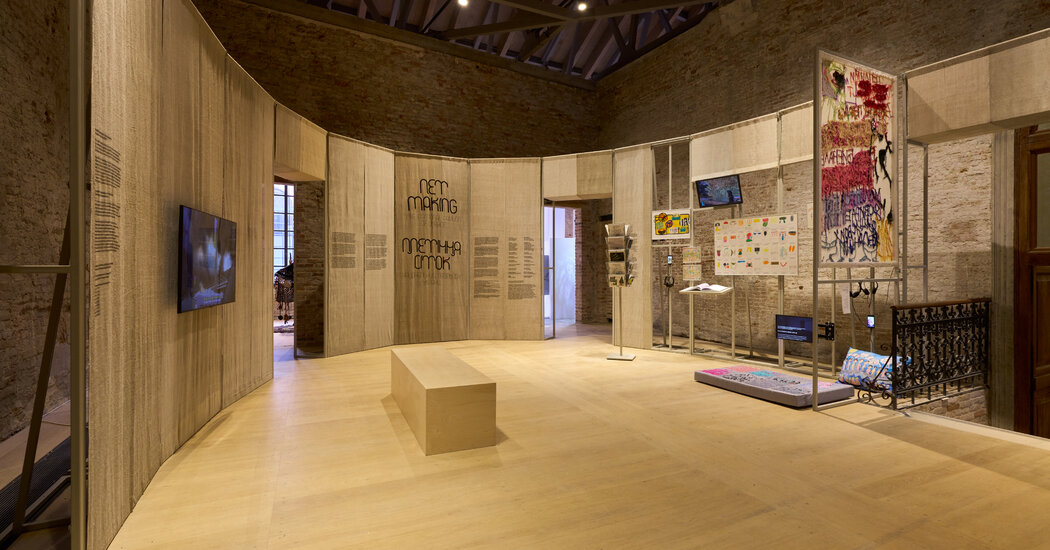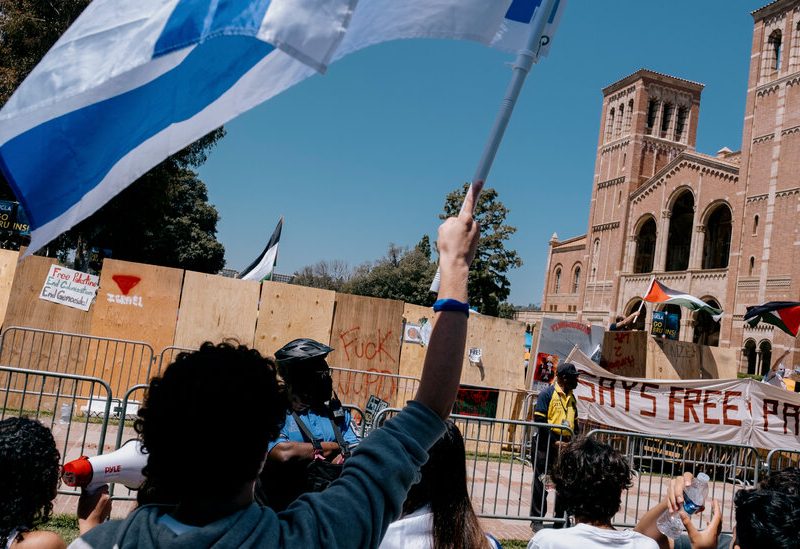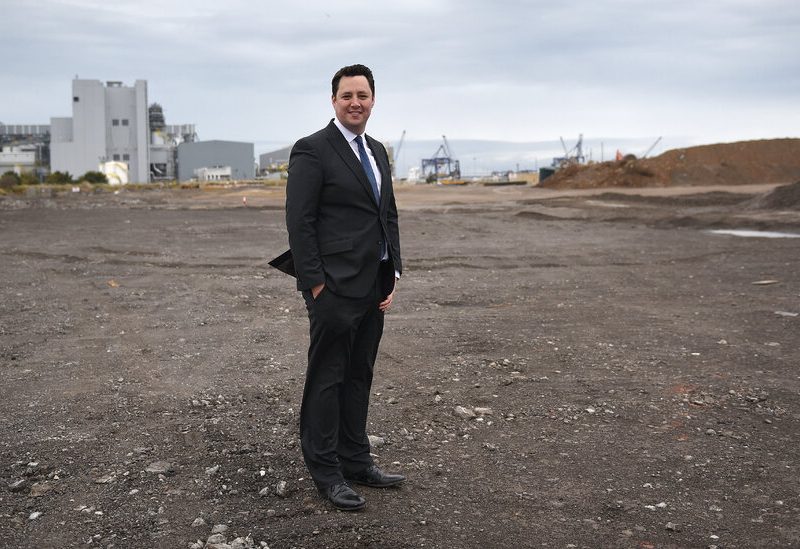It’s Day 17 of Russia’s invasion of Ukraine. A mother hurries back to her underground shelter after a trip to a nearby store. From her shopping bag, she pulls out two ice cream cones, and watches her young son and daughter squeal in jubilation as they tear open the wrapping.
This is one of the early scenes in “Civilians. Invasion,” a 56-minute film having its international premiere at the Ukraine Pavilion during the Venice Biennale. Twenty-six months after the start of the war with Russia, it is one of four works being presented by Ukraine.
Made by the artists Daniil Revkovskyi and Andrii Rachynskyi, the film is a compilation of some 200 videos posted on YouTube, Instagram and TikTok in the first few months of the invasion. They show the war not as you see it on the evening news, but as you would experience it firsthand, from the inside.
You witness the moments when bombs fall on apartment buildings, blow off rooftops, crash into moving cars. You see desperate people crowd into dingy shelters. You watch footage of citizens looting in the local mall, and carting away shopping bags stuffed with goods. From a distance, you see an older woman hold up a painting of a religious icon, and, every few steps, kneel, pray and kiss the ground.
As the film draws to a close, there are bodies everywhere: on the streets, in bus shelters or piled up in shell craters. The bodies are unclaimed, and there’s no one to bury them.
What does the film aim to communicate?
“The main message is to show that the war is still going on,” said Rachynskyi in a video interview from Venice, as his wife, the illustrator Iryna Rachynska, translated his words from Ukrainian. He said the film presented “the collective experience of Ukrainians,” and was “not just art: it’s evidence of the war and of the Russian aggression against Ukraine.”
When the invasion began, Rachynskyi said, he and his co-director plugged the name of each new territory that came under attack into social media search boxes to track down corresponding posts. He said they had sourced as many as 2,000 videos, which they downloaded and whittled to the 200 in the film.
The Venice Biennale was established in 1895 as an exhibition of new and recent art from around the world. It ranks as the world’s oldest international art exhibition.
Soon after its creation, organizers invited countries to build their own pavilions. Belgium constructed the first one in 1907. Today, 87 countries have official exhibitions in Venice, either at the Biennale’s dedicated sites — the Giardini, the public gardens located in the east of the city, and the Arsenale (Venice’s former shipbuilding compound) — or in Venice’s city center.
Ukraine is one of them. Its pavilion is in the Arsenale, inside the Sale d’Armi. This year, the pavilion is supported by the Ukrainian Ministry of Culture and Information Policy and by the Open Eye gallery in Liverpool, as well as by the United States Agency for International Development, the European Union, Germany’s Goethe Institut, the British Council and PEN America’s Artists at Risk Connection program.
The pavilion’s public programming is also receiving financial support from Museums for Ukraine, an initiative set up by the patron and philanthropist Francesca Thyssen-Bornemisza at the outbreak of the Russian invasion of Ukraine to protect, preserve and celebrate Ukraine’s collections of art and culture. Thyssen-Bornemisza is collaborating with the Ukraine Pavilion on its public program, which will be hosted at Ocean Space, the headquarters of TBA21-Academy (Thyssen-Bornemisza Art Contemporary) in Venice.
Pavilions serve as cultural outposts for their countries, so in times of conflict, a pavilion can draw attention to its nation’s plight. The Ukraine Pavilion this year is no exception: During its official opening on Thursday, it planned to feature a live video message from Ukraine’s first lady, Olena Zelenska.
The pavilion’s co-curator, Viktoria Bavykina, said in a video interview from Venice that this year’s artists had been selected based on their sensitivity and empathy toward the plight of the Ukrainian people, because the pavilion “is not only about the artistic community: It’s about all Ukrainians.”
She gave the example of her own parents, who lived “in total fear” in the war-torn city of Kharkiv, where “you don’t know what will happen in the next few seconds.” They still went to work, paid their taxes, and took care of their families, she said, as did all Ukrainians, because war was now “our normal life.”
Her fellow curator (and husband), Max Gorbatskyi, said that the artists this year “focus on something which is outside their artistic bubble,” meaning “real stories, real people,” and that they “challenge the conventions of artistic representation.”
The Ukraine Pavilion presentation is titled “Net Making,” referring to a widespread practice in present-day Ukraine: People gather in net-making workshops to assemble and weave camouflage nets, which are then used by the armed forces to conceal tanks and other weapons, as well as hide-outs, from enemy eyes.
Though no actual nets are woven inside the pavilion, one installation — “Work” by Oleksandr Burlaka — symbolizes collaborative projects. It consists of an oval-shaped three-meter (about 10 feet) high structure arrayed with woven linen fabrics that date back to the 1950s or earlier and have been kept by Ukrainian families across generations for use in various domestic functions. These have been sourced from families all over the country, as well as purchased online.
“Best Wishes” by Katya Buchatska is an installation composed of videos, paintings, postcards and textiles produced by neurodivergent artists. They demonstrate how everyday language has changed since the invasion, and taken on different meanings: how war transforms the most basic words and greetings we use to communicate.
“Comfort Work” by Andrii Dostliev and Lia Dostlieva is a set of filmed portraits of five people (played by professional European actors) who sit silently in front of the camera, dressed in ways that represent stereotypes of how Ukrainian refugees look and behave.
One is a recent escapee from her homeland; she has dirt on her face and a shining foil blanket that people are wrapped in during emergencies. Another is a Barbie-doll-like Ukrainian — a young blonde wearing lots of makeup.
Gorbatskyi, the pavilion’s co-curator, said the theme of the Pavilion worked well with that of the 2024 Biennale’s central exhibition, “Foreigners Everywhere,” because the sense of foreignness and otherness was familiar.
He said he hoped visitors would “become more sensitive to understanding the various experiences of otherness.”
“Ukrainians living in Ukraine, those who experience war, can also be seen as ‘others,’ because their life is different,” he added.



